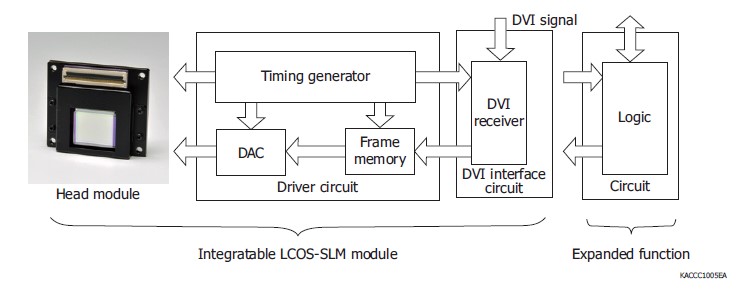
- HOME
- 產品介紹
- 半導體事業部
- Hamamatsu Photonics
- LCOS-SLM
- LCOS-SLM (for industrial applications)-X15223 series
LCOS-SLM (for industrial applications)-X15223 series
![]() +886-2-8772-8910
+886-2-8772-8910
Easy to integrate cooling function to the head module
Modulates only the phase of light
High light utilization efficiency
High diffraction efficiency
High power handling capability
Reflective type
Trigger function
Optical manipulation
Wavefront correction
Pulse shaping
Optical testing
DVI interface circuit for evaluation


|
Parameter |
Number of pixels |
Pixel pitch |
Effective area size |
Fill factor |
Input signal |
|---|---|---|---|---|---|
|
X15223 series |
1272 × 1024 |
12.5 |
15.9 × 12.8 |
96 |
Digital Video Interface |
|
Parameter |
Supply Voltage |
Operating temperature |
Storage temperature |
Withstand pressure of water stream connector |
|---|---|---|---|---|
|
X15223-01/-02/-03/-05/-07/-08/-13/-16 |
16.5 |
+10 to +40 |
-20 to +55 |
- |
|
X15223-02L/-02R/-03L/-03R/-16L/-16R |
0.3 |
|
Parameter |
DVI signal format |
Input signal level |
DVI frame rate Typ. |
Input voltage (DC) |
Power consumption |
||
|
Min. |
Typ. |
Max. |
|||||
|
X15223 series |
1280 × 1024 |
256 |
60 |
15.5 |
16 |
16.5 |
16 |
|
Parameter |
Readout light wavelength |
Light utilization efficiency typ. |
Rise time*2 |
Fall time*2 |
|
X15223-01 |
400 to 700 |
79 (633 nm) |
5 (633 nm) |
25 (633 nm) |
|
X15223-02 |
800 ± 50 |
97 (785 nm) |
30 (785 nm) |
80 (785 nm) |
|
X15223-02L |
||||
|
X15223-02R |
||||
|
X15223-03 |
1050 ± 50 |
97 (1064 nm) |
25 (1064 nm) |
80 (1064 nm) |
|
X15223-03R |
||||
|
X15223-05 |
410 ± 10 |
97 (405 nm) |
10 (405 nm) |
20 (405 nm) |
|
X15223-07 |
620 to 1100 |
82 (1064 nm) |
10 (1064 nm) |
80 (1064 nm) |
|
X15223-08 |
1000 to 1550 |
82 (1064 nm) |
30 (1064 nm) |
140 (1064 nm) |
|
X15223-13 |
530 to 635 |
97 (532 nm) |
10 (532 nm) |
25 (532 nm) |
|
X15223-16 |
510 ± 50 |
97 (532 nm) |
11 (532 nm) |
34 (532 nm) |
|
X15223-16L |
||||
|
X15223-16R |
Light utilization efficiency
The X15223 series have high light utilization efficiency, which is defined as a ratio of the 0th order diffraction light level to the input light level. This high light utilization efficiency mainly depends on reflectivity, and the amount of diffraction loss caused by the pixel structure. We adopted advanced CMOS technology to make the diffraction loss smaller. As a result, the diffraction loss is less than 5%. The -02/-03/-05/-13/-16 types have a dielectric mirror which has high reflectivity. The -01/-07/-08 types have relatively low reflectivity compared to the ones with the dielectric mirror but have wide spectral response characteristics and high linearity.
|
The X15223 series can achieve phase modulation of more than 2π radians over the 400-1550 nm readout wavelength range. The X15223 series comes pre-calibrated from the factory for a specified wavelength range to have more than 2π radians of phase modulation and high linear characteristics. Figure 2 shows typical phase modulation characteristics. A phase modulation of 2π radians or more and a linear phase response are achieved. The phase modulation curves for 95% pixels lies within ±2σ. |
[Figure 2] Phase modulation (typical example) | |
 |
